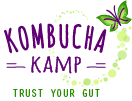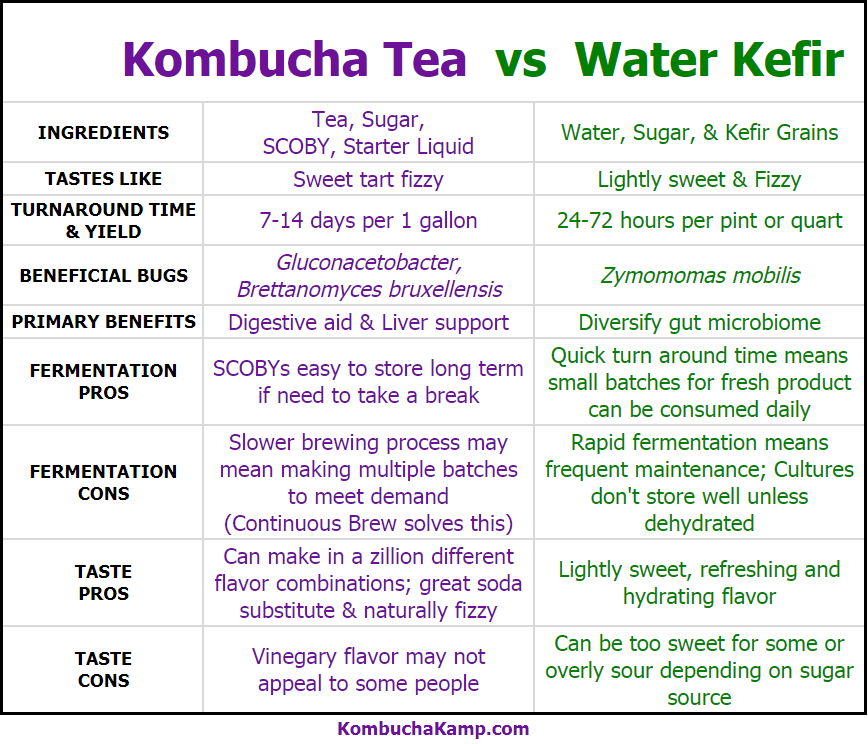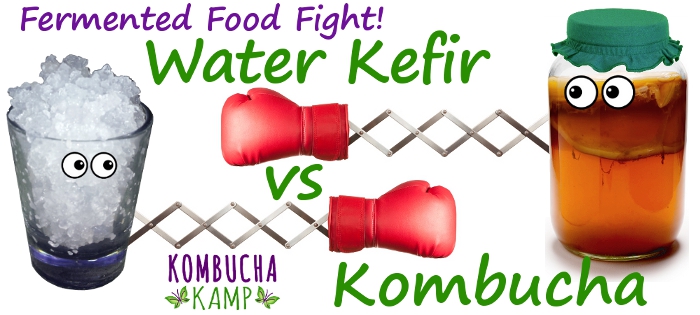
Water Kefir vs Kombucha – Fermented Food Fight!
Fermented drinks have evolved with humans and have been part of every society on record. But if you could only have one, how would you choose? Let’s compare the pros and cons of Kombucha vs Water Kefir to find out which is your favorite!

“In this corner, origins unknown but rumored to be a native of the harsh Mexican desert, this bubbly blast of sweet sour is ready in a hurry, looking to take down big soda one converted kid at a time…let’s hear it for Water Kefir!”
“And in the other corner, weighing in for the acetic acid ferments all the way from China, it’s ancient, beloved, teeming with nutrients, and packs a powerful punch…make some noise for Kombucha Tea!”
With two heavyweights duking it out, who will emerge the winner of the Water Kefir vs Kombucha Fermented Food Fight?
ROUND ONE – WATER KEFIR
Water kefir is the easiest, simplest, and least expensive culture fermented beverage in the world! Besides the “grains” (more about that later), literally all that you need are sugar and water. It brews up fast, in just a couple of days. And with the right recipes, it’s easy to mimic and improve on the taste of everyone’s favorite sodas, with a fraction of the actual sugar. A refreshing, lightly sweet beverage, water kefir is a formidable foe in this fermented food fight. A favorite of newbies due to it’s smoother flavor, everyone should try making this quick and delicious option at home.
With likely origins in the New World, perhaps gleaned from the paddles of the prickly pear cactus in Mexico, they are also known as “tibicos” or “California sea bees.” The grains are placed in a sugar water solution and the microorganisms convert the sugar into mild acids and other bioavailable nutrients. Water kefir can get quite fizzy sometimes, even more so than Kombucha, especially in the summer or during warmer months.
No Pain, No “Grains”?
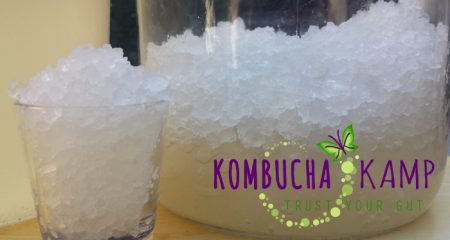 The kefir crystals are called “grains”, however this is just a term of convenience. Water Kefir are not actually made from grain at all, and therefore do not contain any gluten. Instead, the “grain” is a polysaccharide crystalline structure that the bacteria and yeast create. They make this little “house” for themselves, which then makes it possible to share the brew with others. Nice survival trick those little happy microorganisms have developed!
The kefir crystals are called “grains”, however this is just a term of convenience. Water Kefir are not actually made from grain at all, and therefore do not contain any gluten. Instead, the “grain” is a polysaccharide crystalline structure that the bacteria and yeast create. They make this little “house” for themselves, which then makes it possible to share the brew with others. Nice survival trick those little happy microorganisms have developed!
Like all pets or plants, these grains have specific needs: they like to eat certain foods and hang out in the right conditions to thrive and reproduce. However, they are also incredibly flexible and, once you have extras on hand, can be used to ferment a wide variety of substrates including fruit juice, coconut water and more! Highly prolific, extra grains can even be eaten like a probiotic pearl or tossed into a smoothie.
If for any reason you are avoiding all sugar, even the smaller residual amounts of sugar in home ferments, then you can also use them to ferment coconut water or other liquids. Sometimes we do that by adding the grain directly to the liquid in the case of coconut water. Other times we add the already fermented water kefir to other liquids so the grains don’t disintegrate.
CLICK HERE for the Coconut Water Kefir recipe.
For example, to create a fermented non-dairy kefir, add already fermented water kefir to soy, coconut or other non-dairy milks and the organisms in the liquid will break down the proteins. Or add to fruit juice for a bubbly, probiotic beverage.
Grain Break
If you need to take a break, store them in the fridge. The first few batches after pulling them out of the fridge may take longer to achieve the same bubbly vibrancy. Feed them every 24 hours until they bounce back.
Sometimes, if permitted to remain without feeding for an extended period of time, they may simply decompose or “eat themselves.” For longer term storage, coat the grains with a light dusting of sugar and dehydrate. They can be kept indefinitely out of direct sunlight and reactivated when needed. (*note: don’t try this with milk kefir grains, it doesn’t work!)
The Recap
WHAT IS IT?
Water kefir is fermented sugar water. Kefir grains (not actually a grain, rather a polysaccharide composed of sugar loving bacteria and yeast) are added to a sugar water solution and fermented on the counter for 12-48 hours. The resulting product is light and refreshing.
HOW’S IT TASTE?
Water kefir is a little bit sweet with a mild tang. Different food sources (sugar types, coconut water, etc.) change the flavor and can make the final beverage more or less sweet or tangy. It is versatile and you can flavor with fruit, juice or herbs.
CAN I BUY IT AT THE STORE?
Water kefir is often found next to the Kombucha in the grocery store. Some commercial brands do not use a culture. Instead, they add a powdered probiotic to flavored water. Other brands use an authentic kefir grain. Coconut water kefir is also available commercially in health and specialty stores.
WHY DRINK IT?
Our bodies need a diverse range of probiotics. Adding water kefir is easy and the flavor is refreshing. Lighter and sweeter than Kombucha, it can be more palatable for some people. Any number of beverages will blend with water kefir for a bubbly boost.
HOW EASY IS IT TO MAKE?
As easy as it gets: add the water kefir grains to sugar water, cover and then 12-48 hours later it’s ready to drink!
CLICK HERE for the complete Water Kefir Recipe and Tips Page
CONS?
The flavor profile can be too sweet for those accustomed to the tangier bite of Kombucha. While the grains don’t tolerate a longer fermentation time, the water kefir may be bottle aged to yield a less sweet flavor. Since the grains have such a quick turnaround time, some may find the upkeep too demanding.
ROUND 2 – KOMBUCHA
Kombucha is today’s best choice for replacing your soda or energy drink. Refreshingly tangy with just a sweet hint and a light tickle of effervescence, Kombucha can be flavored just about any way you can imagine. Many say it’s a lot like drinking a soda, however we think it’s much better. Plus, a healthy Kombucha brew has a variety of organic acids, enzymes and more to help naturally improving digestion and support the liver.
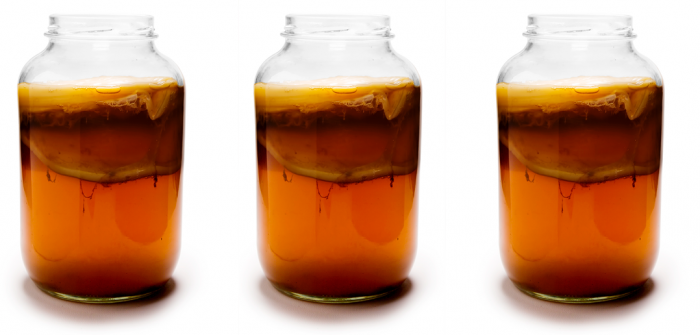
Another great option: if used to replace or mix with alcohol, Kombucha is the bomb! Naturally occurring B-vitamins, like those packed into over-the-counter hangover cures, as well as glucuronic acid help to counter the morning after issues from too many cocktails. Mix it right into your favorite drink recipe or create fun and bold mocktails. Many say drinking KT also reduces cravings for alcohol or eliminates them entirely; frankly that’s been our experience. Trust YOUR gut!
Boochin’ Ain’t IS Easy!
Like all our home ferments, Kombucha is easy to make; if you can brew a cup of tea, you can make Kombucha! Patience is required once the brew has been started, but there’s no special skill needed other than the desire to make a healthy beverage for yourself at home. Primary fermentation can take a week or longer, up to 21 days if the brew is on the cooler side.
We call flavoring in the bottle secondary fermentation, and takes a few days as well. We even age our Kombucha in the bottle for a few weeks, which means we have to wait even longer for ours to be ready! But you don’t have to, just drink it when you like the taste.
Adding flavorings is a big part of the fun and creativity of brewing Kombucha, but it’s not a requirement. If you like the flavor of the plain brew, you get to drink it even sooner!
The Recap
WHAT IS IT?
Kombucha is fermented sweet tea. A Kombucha SCOBY (Symbiotic Culture of Bacteria and Yeast) along with already fermented Kombucha are added to the sweet tea mixture (tea and sugar). This brew is allowed to ferment aerobically (with a cloth cover) for 7-14 days (or longer as needed) to yield a naturally carbonated, tangy beverage. The primary acid present in Kombucha is acetic acid, like vinegar.
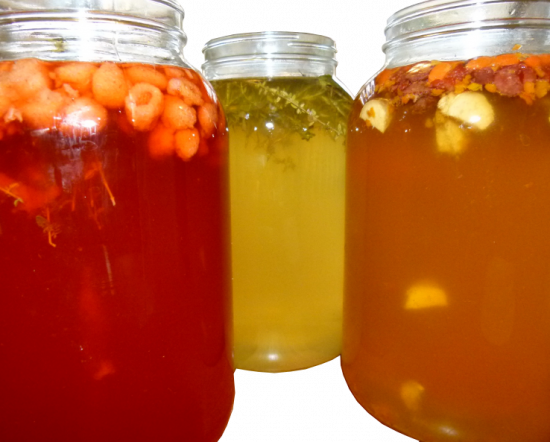 HOW’S IT TASTE?
HOW’S IT TASTE?
Kombucha typically has a balance of tangy and sweet, with some brews ranging more towards sour. When making it at home, we have the option of tailoring the flavor to our preferences. KKamp always recommends flavoring and bottling the brew when it has the flavor you enjoy most. The acidity of Kombucha can be a wonderful counter balance to heavy and rich foods at any meal. Or try it anytime you want a digestive boost.
CAN I BUY IT AT THE STORE?
Yes! These days you can find Kombucha just about anywhere: health food stores, co-ops, farmer’s markets, and hipster bars have long been on the Kombucha train, but now even mainstream grocery stores, corner convenience stores, airports, and Costco are stocking the booch. If you like, you can find Kombucha just about anywhere. There is a large range in flavor and brewing style among those available at the store, sweet and light to downright sour, so try a few to see what appeals to your flavor palate.
Production methods vary greatly: you can find traditional brewed Kombucha right next to pasteurized products and others that are watered down concentrate. Buyer beware! Look for bottles that say raw or have yeast and SCOBY floating in the bottle for more traditional brews. Quality also does tend to cost little more. Of course ANY Kombucha is a superior choice to high sugar sodas and juices, no matter how it’s brewed. Some brands add non-native probiotics, and they can often be stored at room temperature since they are not active.
WHY DRINK IT?
Kombucha has organic acids and enzymes that support digestion and liver health. It makes a great substitute for soda, energy drinks and even beer and wine. The most common benefits people claim are more energy, better digestion and overall just feeling good!
HOW EASY IS IT TO MAKE?
Let’s hear it again: “If you can brew a cup of tea, you can make Kombucha!” Brewing is a blend of science and art, and when mastered creates delicious Kombucha every time. But each person’s perfect batch is different! In comparison to kefir, many like the longer fermentation time of the Booch since they can leave it alone for a week or more until it’s ready. Continuous Brew makes it even easier.
CLICK HERE for more about Continuous Brew vs Batch Brew Kombucha
CONS?
Longer fermentation times means having to wait for the brew to be ready. Some people may forget about the brew in the meantime! For the newbie, the taste can be a challenge, especially if one is not already a fan of things like pickles and sauerkraut. However, more than a few people have made a squished up “Kombucha Face” as we call it when taking their first sip and then become the biggest Kombucha lovers out there! So give it a chance, flavor with your favorite options, you can even add a little water to dilute the acidity. Whatever it takes, try Kombucha and see how it makes you feel!
AND THE WINNER IS?
YOU!!
(Okay, we admit, the winner is always you. But it’s true, we all win with home ferments!)
Whether you prefer the quick and easy fun of Water Kefir or the powerful punch of flavor from Kombucha, you are the winner of the Kefir vs Kombucha battle just by diversifying your diet with as many fermented foods as you enjoy.
Why not make it a double play this time and brew both at home for you and the family?
What’s Next?
Make your own at home using these convenient kits!
Kombucha Batch Brew Starter Kits
